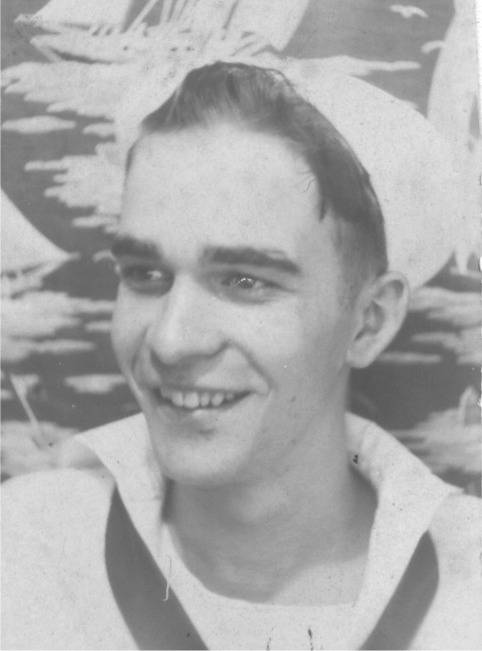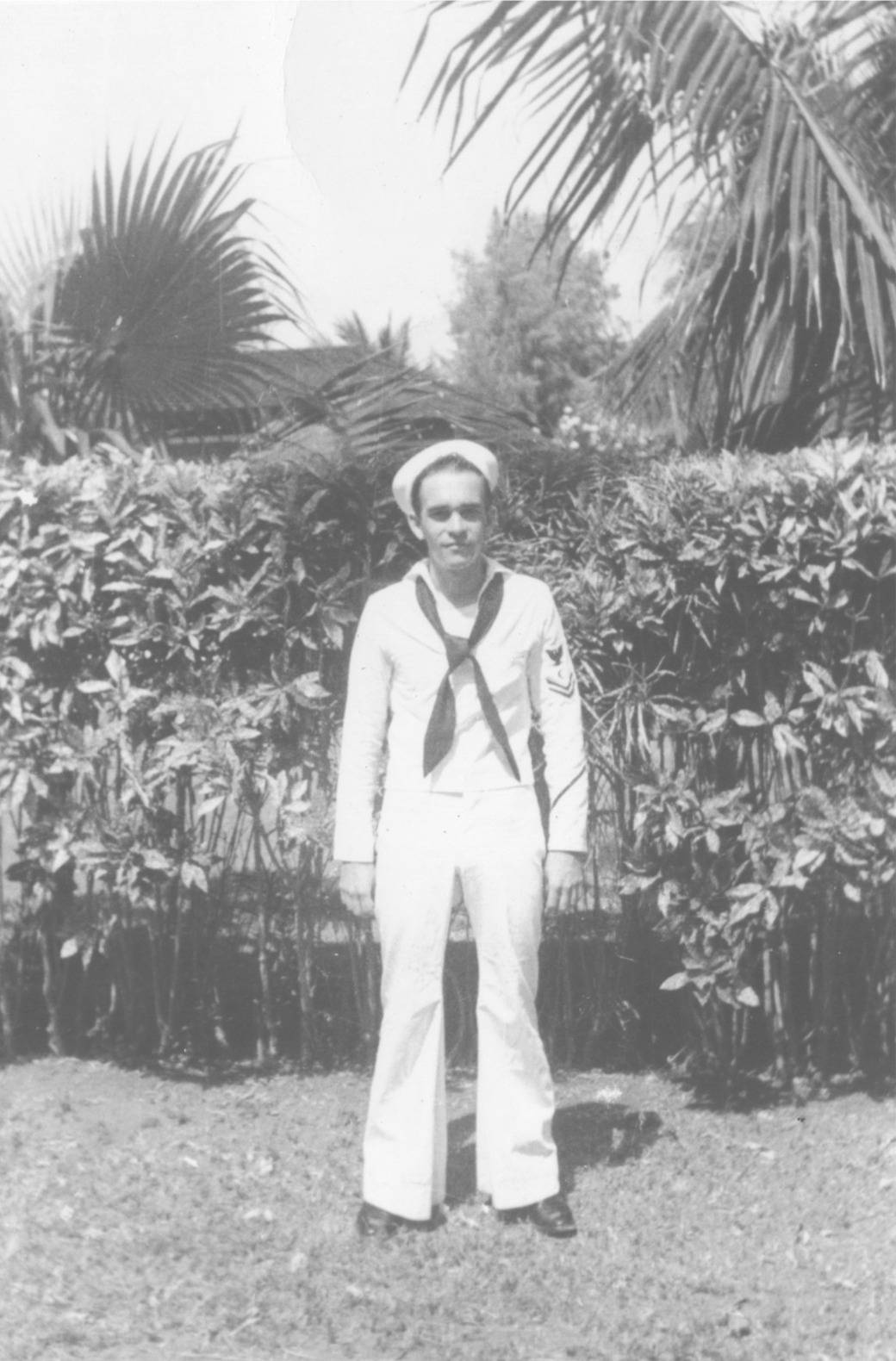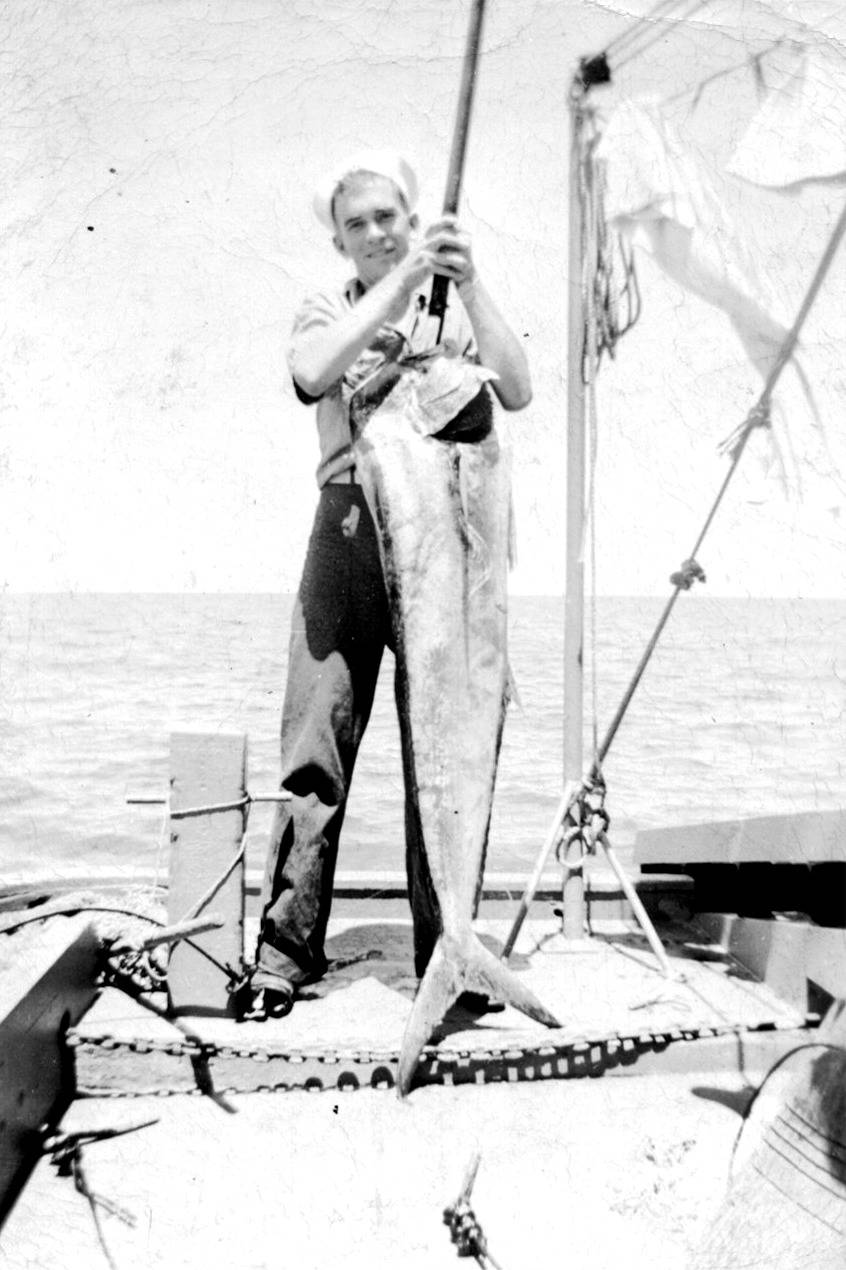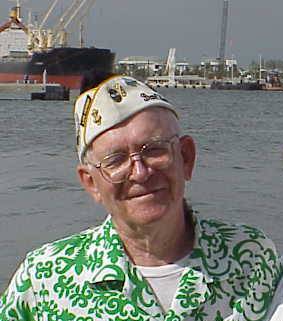Charles J. Haessig US Navy USS Sacremento |
Information provided by Charles J. Haessig. |
The USS SACREMENTO had been in dry dock for about two weeks having its hull scraped and painted. The dry dock was a very large hole in the ground; it held both the Sacramento and the battleship USS California at the same time with plenty of room. They bring the ships into dry dock and then pump out all the water, before hand they set up a large platform to hold the ships. I was a member of the crew of the USS SACREMENTO. My name is Charles John Haessig USN, 410-43-07, First Class Seaman, aged 20 years and 4 months, working in ship service. The ship was towed to a dock around side of the dry dock where there was a very large crane that had removed part of our engine. This crane was four or five stories high! I am telling you this, only because I believe that the crane saved our ship and the crew. This all happened before December 7th. We came out of the dry-dock about December 4th. Sunday December 7th dawned a very beautiful day with blue skies and sunshine. I awoke at first call for breakfast, which was about 6AM. I shaved and showered and put on my best white uniform because I was going ashore with the church party at 08:00AM. Our ship did not have a Chaplain on board so we were allowed to go to church in the beach, which meant we could go into Honolulu for church. I had my breakfast and went topside about 07:45AM. We had to report to the quarterdeck for inspection by the officer of watch and if we passed had to wait until 08AM to leave the ship. At 07:55 we heard the roar of airplane engines and we thought not again. The Navy had been practicing dive-bombing for several days. About that time a plane came right over our ship, he was very low and we could see the pilot looking down at us. That airplane had the largest red ball painted on its side that I've ever seen. I dove down the hatch and started yelling, “ The Japs are attacking us. Shoes, pillows and words that I won't repeat were thrown at me, at that time there was a loud explosion nearby and the crew came out of their bunks, running to their battle stations. My battle station was an at sea station #8221. The ship's Barber and I would go two decks down to the rear of the ship, crawl through a hatch and if we got the word from the bridge, we would knock the pin out of the steering cables so they could steer the ship by a rear tiller. This was in case the bridge was hit we could still control the ship. As you can see, this was useless when you are in port. John Sterns, the ships Barber and I talked it over and decided that this was useless so we ran back to the armory and started helping drag ammunition across the deck to a hoist that took it up to the bridge where the fifty caliber machine guns were. Our air defense was two fifty caliber machine guns on each side of the ships bridge and two thirty caliber machine guns mounted aft on the boat deck. These guns were very busy by now and it kept us busy feeding them. Most of the action happened so fast that we didn't have time to think about our own safety, we just kept going. There was a ladder and a hatch near us and now and then we would run up the ladder, push up the metal hatch and peek out, it was a very sorry sight. I saw the USS Arizona explode and sink, the USS Oklahoma started rolling over and sinking, all the battle ships had been hit and were on fire, oil was all over the water and it was on fire. Through all this there was a little Navy tugboat, right there in the middle of the battle, fighting fires, pulling men from the burning waters and helping wherever she could. Later I found out it was the USS Hoga YT146. What a little hero. She pushed the USS Nevada up on the beach to keep her from blocking the harbor. Back on the Sacramento we were doing pretty good, the Jap planes had been fewer and we got a little breather. By 13:00 (1PM) we stopped firing because the planes had disappeared so we got a break. Our cooks had fixed hot dogs in sauerkraut with a big slice of homemade bread and to this day nothing has tasted so good! Three of us, I don't remember who, probably John Stearns, went up on the boat deck with our food and sat down to eat. We finally began to realize what had happened to us. My beautiful white uniform was now in shreds, my highly polished shoes were scratched and dirty. I was a mess. The Harbor was still burning, the Arizona was on the bottom with her mast sticking up above the water. The Oklahoma was belly up in the water, most of the battleships were sunk or badly damaged. They were still pulling en from the burning waters, some were injured or burned from the burning oil and water. Motor launches (small boats) were busy rescuing men and bringing them ashore where the hospital corpsmen were taking them to the hospital. There were no more Jap planes after that and we were very glad. Most survivors don't talk about the night of December 7, 1941, but I will. I was almost shot. At sundown as colors was blown (that’s when we lower the American Flag) I saw a sailor or marine dive off the dock by the USS Arizona and swim out the flag staff that was just above water and lower the tattered piece of flag that was left on the staff. Boy I wish I could have had a camera, but we weren't allowed to have cameras on the ship. As dark approached they decided to put a man in the crows nest, guess who got the job! Our ship had been moved to a dock away from the huge crane we were under. We were assigned a code number of Dog-Afrim-One-Afirm, which meant we were the first to report in if we saw any planes coming in. The USS Enterprise, an aircraft carrier, was supposed to be in Pearl Harbor but at the last minute went to sea or we would have lost her too. Anyway, that night I was up in the crow's nest with radio contact to headquarters when I spotted two planes coming right across the Harbor. My orders were that if the planes were friendly, they would follow the Harbor channel in. These weren't doing that. So what else could I do but pick up the phone and shout Dog-Afrim-One-Afirm, rattlesnake dead ahead. (If we reported Dog-Afrim-One-Afirm Hayrake, which meant friendly planes). After that all hell broke loose, bullets were flying everywhere. I came down out of that crow's nest and down the ladder like a streak of lightening, I believe that God was with me that night. Every able ship in the Harbor was firing! Later we found out the two planes we shot down were from the Enterprise. The good thing was that the two pilots parachuted down and were safe, it was their fault, and they had not followed the orders and came in the wrong way. With all the confusion, I could see how that could have happened. The next day, Monday December 8, 1941 was a clean up time for all the ships in the Harbor that were still afloat. Our ship was put back together and we got underway, we went to the back side of Ford Island and tied up along side of an old ship, the USS Baltimore (sp), which was the last ship of Admiral Dewey's white Fleet. The ship was a minelayer and two of us slipped aboard to look around. The radio operator sat in a glassed in box like a refrigerator so he could broadcast and be heard. There were tracks down the middle of the ship, this was for little cars that carried mines to the rear of the ship where they were dropped into the sea. The galley was very old with coal fired stoves and the ship was also powered by coal boilers. We didn't try to go too far below because someone said there were large wharf rats aboard. The reason that we were put on this side of Ford Island was to watch for Jap subs, as there was one that supposedly slipped into the Harbor during the attack. Whenever our lookout saw a periscope, they reported it to headquarters and the PT boats would come in and drop deep charges on the sub. The reason the PT boats were used was that the water was shallow and the PT boats could get away from the explosion. After about a week of watching for Jap subs we got orders to go to Hilo, Hawaii, the big Island, two active volcanoes and we got to see one erupt. Our ship had a crew of mostly men from the Indianapolis Indiana area so we had to be broken up. This was because if the ship was sunk or hit by bombs, the loss of all the men from one particular area would have been a tragedy. I was transferred to a rag-tag fishing boats made into sub patrol boats. This is the end of my Pearl Harbor story although I returned many times over the following three years. After thoughts Captain Rockwell took command of the USS SACRAMENTO about six months before Pearl Harbor. He was a very handsome man, he looked like a movie star! We had trouble with some of our reserve officers, they were under the impression that they could walk on water. This lead to several court marshals of the crew, so he was sent in to straighten the whole crew out including the officers. Capt Rockwell wanted two orderlies for his use. I was in ship service running the broken down laundry so I was selected as one orderly. Dick Rayburn was also between jobs so he was number two. Our new job was being a messenger for the Captain. The Captain really whipped the ship and officers into shape. He would time general quarters crew with a stopwatch. This would be any time during the night or day. We had to do it over till we got it right, The ship went to sea and we also had target practice. About on week before December 7, 1941 the Captain was transferred to Egypt! In his farewell speech he said, "You men might feel that I treated you harshly by making you get to your battle stations very quickly, but in the very near future you will thank me". Later I found out he was Naval Intelligence. He was the man who whipped the crew into a fighting machine, who we credited with shooting down three Jap airplanes. Who said we didn't know it was coming? Why was Captain Rockwell transferred, just before the attack on Pearl Harbor? In closing As I look back after sixty years, I thank God that the Japanese didn't have several landing ships with their aircraft carriers because with the condition of our forces we would have surely been defeated. God was surely with us that day, even though at that time a lot of us didn't realize. |



